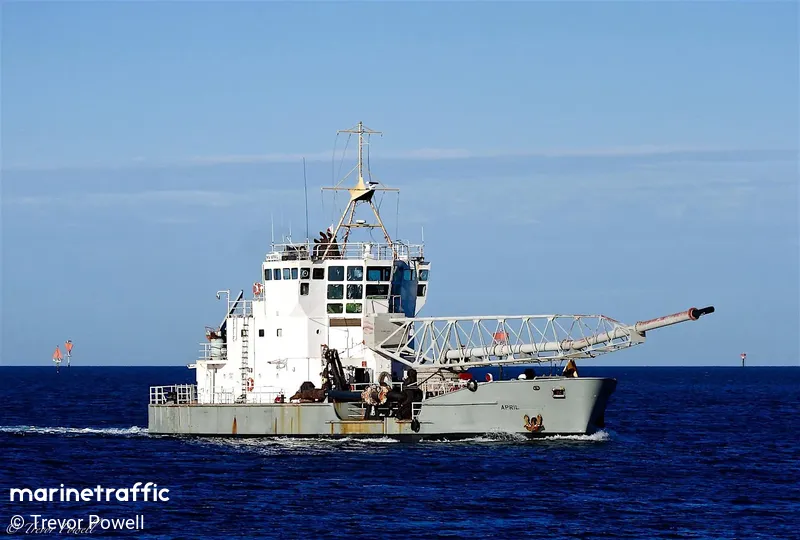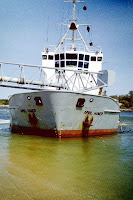Many will well remember the April Hamer, a side casting dredge which worked on station at Lakes Entrance keeping the entrance open and navigable for many years. Without intervention, the sand would have closed the access to Bass Strait on many an occasion as is the case with Lake Tyres.
 |
| April Hamer working at Bullock Island c 1997 |
April Hamer was Built at Carrington Slipways, Newcastle in 1976 as a small trailing suction dredger
and worked year in year out in the main channel of Gippsland Lakes at its opening into Bass Strait at Lakes Entrance. It was owned and operated by Gippsland Ports.
 |
| Fishing Vessel enters Entrance when badly silted |
Although on station throughout its life, apart from timely re-fits, the entrance was slowly but surely being blocked by the sand being washed into its mouth by tide and current flow from the lakes system often made worse by winds. This made it highly dangerous, indeed treacherous to navigate especially at low tide and had a huge impact on the fishing fleet, the largest in Victoria using Lakes Entrance as home port. The condition of the waters in the vicinity of the entrance was blamed for many a nautical mishap.
 |
| April Hamer at Sea |
For the technically minded, April Hamer had the following dimensions; Length (OA): 39.37 m
Length (BP): 38.21 m Width: 11 m Depth: 3.64 m Draft (loaded): 1.76 m Number of engines: 2
Engine specs: Caterpillar - D379TA - Str - cyl - - rpm Total power: 1722 kW Hopper volume: 841 m³
 |
| April Hamer from Bullock Island light |
Perhaps not the vessel with the most pleasing lines, she was part of the town for 34 years and now part of the towns history having been replaced in 2008, (although stored in North Arm until 2011), now about 10 years ago since she worked the Lakes Entrance port scene. April Hamer, (named after Premier Hamer's wife), was of interest to many mariners and seafarers for the role she played for so long keeping the towns nautical traffic through the entrance open as best she could.
 |
| Wide beam, not the most pleasing lines ! |
After many years it was time to retire April Hamer, she was not able to keep pace with the sand in the entrance effectively, was old and in need of re-fit/repair. Being a side casting dredge she was only able to move sand a comparatively short distance to either side dependent on tidal drift at the time. Enter The Pelican, a contracted Hopper Dredge, which, as its name indicates was able to suck up sand and place it out at sea to be swept away from the entrance by prevailing wind and tide.
 |
| Pelican with its namesake |
The Pelican is a Hopper Dredge meaning that she was able to hold a large amount of sand in the hull then move well away from the entrance to drop it to the east or west dependent on the conditions at the time. For the technically minded; Vessel: TSHD Split-hull Flag: NL Owner: Van Oord NV.
Manager: Van Oord NV. Built: 1979 Shipyard: Scheepswerf Stapel BV, now part of Vosta LMG.
(NB : TSHD Trailing Suction Hopper Dredge)
 |
| Pelican enters Reeves Channel on first trip |
The Pelican was often seen in the main channel as well as in the area of the entrance approaches removing the sand and maintaining a navigable channel. It did however lack some power when compared the April Hamer and so was limited from time to time due to prevailing weather conditions. Length (OA): 62.62 m. Length (BP): 59.31 m. Width: 11.21 m. Depth: 4.27 m. Draft (loaded): 3.71 m. Number of engines: 2. Engine specs: Smit-Bolnes - 3DNL 150/600 - 2Str - 3 cyl - 19.00 x 35.00 - rpm. Speed (loaded): 10 knts. Total power: 1504 kW. Hopper volume: 965 m³. Dredging depth: 13.2 m. Dredging depth (extended): 20 m. Suction pipe diameter: 0.45 m. Number of dredging pipes: 1
 |
| Split hull clearly visible at bow |
The Pelican was quite a sight when moored at Bullock Island with her distinctive split hull clearly visible at the bow, also used by many of its namesake for shelter from the weather. When working up the Narrows towards Kalimna Jetty she made an impressive sight especially at dusk.
 |
| Impressive sight at dusk |
It would be remiss not to mention The Kalimna, a purpose built smaller cutter dredge commissioned by Gippsland Ports to manage the sand transfer system in Reeve Channel and The Narrows since 2007.This dredge is able to connect to a sand movement system of pipes which can distribute the sand out to sea on either side of the entrance dependent of tidal drift etc. If too far from the pumping station she is often seen with a booster pumping station, moored when not in use in North Arm.
 |
| Kalima Cutter Dredge off Bullock Is. |
The Kalimna and its booster pump unit was specifically built for the Gippsland Lakes and is able to dredge in locations not able to be accessed by larger vessels, also able to remove the sand from the area by way of the sand transfer system. (That is another interesting aspect of the area altogether).
 |
| Kalimna clearing main channel |
While the Kalimna continued to operate successfully, The Pelican however after working the entrance for eight years was aging not too gracefully, and in need of replacement for a number of reasons, reliability, cost and effectiveness being a few. After much negotiating and political pressure monies were made available for a vessel to be built capable of successfully maintaining the waters of the Gippsland Lakes, and more especially the Entrance.
In October 2017 just one year ago the Chinese-built dredger, Tommy Norton, was officially handed over to its new owners, Gippsland Ports, and commenced dredging operations later that month.
The dredger arrived in Victoria in September 2017 and had been undergoing trials and training of Gippsland Ports staff before being officially handed over to its new owners.
 |
| TSHD Tommy Norton |
Gippsland Lakes is home to Victoria’s largest commercial fishing fleet and services commercial vessels and offshore oil and gas suppliers, as well as being a popular recreational boating location. According to Gippsland Ports, the economic contribution to the region of the recreational boating and commercial fishing industries operating within and through the port exceeds $200m annually.
 |
| No Dredging = no Fishing = loss of $$ |
In order to maintain reliable access, regular dredging of Lakes Entrance has been taking place for more than a century. Tommy Norton is the latest in a long line of vessels undertaking dredging works in the area.
Summary of dredging vessels at Lakes Entrance
DREDGE NAME PERIOD OF USE TYPE OF DREDGE
Wombat 1879 to 1928 Bucket Dredge
Pioneer 1906 to unknown Suction Dredge
Priestman Pre 1908 to 1963 Grab Dredge
W.H. Edgar 1922 to 1936 Side Suction Dredge
Paynesville 1936 to 1963 Suction Dredge
Sandpiper 1963 to 2005 Cutter Suction Dredge
Mathew Flinders Circa 1970 Trailing Suction Hopper Dredge
April Hamer 1979 to 2011 Side-casting Dredge
Melbourne 2006 to 2007 Cutter Suction Dredge
Kalimna 2007 to present Cutter Suction Dredge
Pelican 2008 to 2016 Trailing Suction Hopper Dredge
Tommy Norton October 2017 current Trailing Suction Hopper Dredge.
 |
| The Entrance on a windy day |
On Tommy Norton's first birthday we should be thankful for all those who keep our entrance as safe as possible and have done so over so many years.
 |
| "For Those in Peril" |
Footnote: Some of the above photographs, and many more local scenes are printed on canvas and on display at Lakes Entrance Visitor Information Centre for sale. Any not on show can be ordered through this site. JM
Sources: Gippsland Ports Info Sheet: www.marinebusiness.com.au/news. : info via dredgepoint.org.: Ships Nostalgia.: Photo April Hamer at sea: Trevor Powell marinetraffic.com.: Photos Copyright John Munns.: Photo Tommy Norton Marinebusiness.com.au
Some time ago there was a boat builder in Kinner Arkansas that built a "Ski Barge" It was a fiberglass boat, with lots of room. Your Sea Barge might be a descendant of that boat. If there is a Hull ID number located on the upper right side if the transom, it will begin with three letters. The US Coast Guard issues these letters to US Boat Builders, and you can check their web site for the company name and any address that might be available. Learn more: workboathire
ReplyDelete